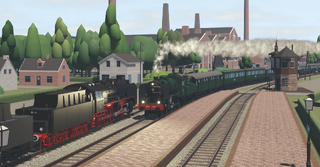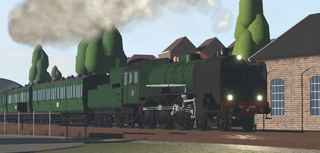NS 4000 by Supersnel11 Price ƒ95.000 Level 27 Statistics Type Passenger Top Speed 120 km/h Weight 127 tons Capacity 370 tons Passenger Capacity 2 first class
2 second classLength 20,8 meters
Not to be confused with the Festive NS 4000. The NS 4000 was class of Swedish 2'C (4-6-0) passenger locomotives that were ordered by the Dutch government for NS, without consulting NS.
Variants
The NS 4000 is available in two liveries, though the second livery just replaces the conical smokebox, as they were built, with an austerity one.
Historical details
The Second World War had dire effects on the amount of available locomotives of the Dutch Railways. In an attempt to aid them, the Dutch government, in London, ordered 50 locomotives at the Swedish factory Nydqvist & Holm Aktiebolag (NOHAB); 15 2'C express locomotives and 35 D goods locomotives (NS 4700) in 1942. The only specifications the Dutch government gave NOHAB was that the capabilities of these 50 locomotives should be similar to those of existing Dutch locomotives.

With nobody being certain when the War would end, NOHAB waited with the start of manufacturing until the end of the war was in sight. To save time, NOHAB decided to base the Dutch locomotives on pre-existing Swedish designs, rather than design some from scratch. The basis for the 4000s was the H3s type of the Bergslagernas Järnväger (BJ), which had been in service since the 1930s. The first locomotive arrived in March of 1946.
After a trial run, it was stationed at the depot Amsterdam Central Station, together with the four other members of the series. These would pull the D-trains (international, long-distance trains for which a surtax had to be paid) to Belgium and Germany. Fijenoord also got a few of the 4000s, also used for D-trains. The third depot where the series ended up was Eindhoven, from where they were used for both goods and passenger trains for a couple months before moving to Amersfoort depot for the trains from Amsterdam and Utrecht to Zwolle and Enschede. The rest of the series was moved to Zwolle depot to pull trains to Groningen an Leeuwarden throughout 1947. Those trains would eventually be taken over by locomotives of the NS 3700 series, so the whole series was stationed at Amersfoort by the end of the year.
The first NS 4000s were temporarily stored away in 1948 because they turned out to be less suitable for the (by Dutch standards) quite hilly Amersfoort - Apeldoorn line across the Veluwe. Their impressive acceleration, in combination with the increase of the maximum allowed speed, made them quite suitable for local trains. The only D-trains they were used for (until 1952) were Amsterdam - Zevenaar and a few D-trains Amsterdam - Nijmegen through Geldermalsen. After the electrification of the line Amersfoort - Zwolle in 1952, few jobs were given to the 4000s. They got to keep the D-trains but were only given the occasional light goods train besides those.
The NS 4000s that still had a steel firebox (4002/03/11 & 4015) were stored away in January, 1953. They were withdrawn in 1954 together with the 4001/04/07/10/12 and 4014. The 4005/06/08 and 40014 were withdrawn in 1956 with the last of the class, 4009, being put out of service in 1957, after less than 10 years of service. The tenders of the 4003 and 4010 were preserved and used for the 'slijptrein', which was a train used to grind uneven track to a smooth state.
Technical details
The NS 4000 were originally equipped with Westinghouse-brakes for both the locomotive and tender, connections for steam heating at the back of the tender, later at the front too, the firebox was secured with two Richardson-mechanisms, Deuta-speedometers, steam-powered brake, electrical lighting powered by an Asea dynamo next to the smokestack, an Asea-lubricator, two Gresham & Craven-injectors type 10 and a welded steel firebox.
The most notable differences between these machines and the BJ locomotives on which they are based were a different model cab and the added smoke deflectors.
The cab was entirely enclosed and designed to be comfortable for the stoker and driver. All of the gauges were located behind the regulator so the driver could see what was going on and where he was going in a single glance. The Deuta-speedometers were eventually replaced with Hasler-Teloc-speedometers.
The frame was a bar frame constructed similarly to those of the NS 3600 and NS 3900.
The boilers had a steam pressure of 12 kg/cm², which was low for the time. In 1947, NOHAB delivered a reserve boiler with a factory number that had already been given to the frame of NS 4702. The stays of the fireboxes only drilled on the outside and the crown stays were, against Dutch regulations, not drilled at all. The boiler tubes were welded to both tube plates, whereas the usual Dutch method was to weld the tubes to just one tube plate, the one near the firebox, but roll them into the plate at the front.
The original steel firebox gave troubles with maintenance. The steam generation was great on arrival, but worsened over time due to deposition of refuse and boiler scale. The arrival of the wrongly numbered boiler in 1947 created opportunities to give the boilers copper fireboxes. The process started in 1950 with NS 4001. Ten more locomotives followed in 1951 and '52. The 4002/03/11 and 4015 were never rebuilt and marked with a painted 'S' or 'K' under the number plate to indicate that stokers had to stoke these four differently.

The smokebox door was very small. Entering the smokebox to clean the boiler tubes required some considerable effort. After the first of the NS 4300 and 5000 were withdrawn, their smokebox doors and mounting rings were fitted to the 4000s.
The steam-powered brake only worked on the driving wheels; the bogie did not have any brakes.
The bogie was capable of moving 55 mm sideways to either side and had a self centering mechanism, which greatly reduced hunting at speed. All three bogies, those of the tender included, were equipped with SKL-rolling bearings, so their friction was minimal. So little, in fact, just eight people could push the 127 ton machines. They did cause some troubles, but those were easily solved.
The three cylinders powered the frontal axle. The Asea-lubricator used steam to suck lubricant into the pistons and valves. Every cylinder had its own valve gear.
The electrical lighting was not only for the headlights, but also for lights that illuminated the wheels and valve gear. This earned them the nickname 'Kerstboom' (Christmas tree), which remained even after the valve gear lights were removed.
The steam dome and sand dome were placed under a single cover.
The two NOHAB series had a third number plate on the backside of the tender in accordance with Swedish customs. Other Dutch locomotives only had a painted number on the back of their tenders.
Trivia
- The NS 4000 is a mid-high level express steam locomotive, with the highest speed for a steam locomotive, and a mediocre class capacity.
- Until the Introduction of the TEEs this was the fastest engine in the game.
- It currently still is the fastest steam locomotive alongside the NS 3950.
- There is a limited festive version, the Festive NS 4000, which was the first festive based locomotive introduced to Streamlined.
- Oddly enough, the Austerity smokebox cannot be used on the Festive NS 4000, despite the choice of smokebox doors being introduced after the release of the Festive NS 4000.
- The dynamo sounds were added much later to the NS 4000, on version 0.4.35.
- The NS 4000 was the longest steam locomotive in the game at 20.8 metres before the Baureihe 50 was added.
- The NS 4000 has been available since the release of the game in version 0.1.
- The Austerity smokebox door livery was added in version 0.4.15.
Gallery
-
NS 4002 passes through Helmelo at speed.
-
NS 4010 leaves Dokmuiden with a wooden passenger train attached.




